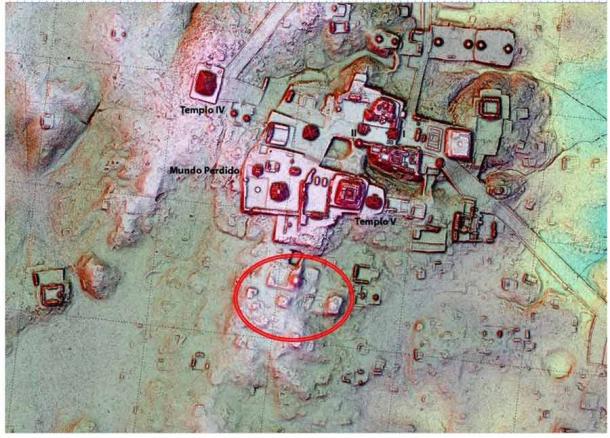Back in 2016, a group of scholars and researchers from the Foundation of Maya Cultural and Natural Heritage (PACUNAM) set out to study the rainforests of Guatemala using LiDAR remote-sensing technology in the hope of uncovering Tikal architecture and remains. Thanks to this superior technology, researchers have been able to make a fantastic new discovery in the hilly landscape of the ancient Maya city-state known as Tikal (formerly, Yax Mutal in Maya).
By piercing right through centuries of dirt, soil, and forest in modern-day Guatemala, they have discovered a pyramid which was seemingly part of an older neighborhood. What especially got the attention of the team was that it had little resemblance to Tikal architecture; rather, it was more like the architectural style and design of Teotihuacan – the ancient rival Maya superpower, now in modern-day Mexico.

LiDAR technology is revealing remains of Tikal architecture which were literally hidden in plain sight. ( Pacunam LiDAR Initiative / Thomas Garrison)
Using Modern Technology to Uncover Tikal Architecture
LiDAR, which stands for Light Detection and Ranging, is a remote sensing method for determining ranges. It uses light in the form of a pulsed laser to measure ranges (variable distances) to the Earth, based on the time taken to reflect the pulse by said object. The corresponding measurement is plotted using a GPS and then computers use the data to reconstruct a 3D map of the area, particularly the topographic features.
In this case the researchers used an airborne LIDAR, aimed directly at the forest, which enabled them to discover what seems to have been hidden in plain sight all along – the remains of a bourgeoning Maya kingdom, dating back to the Classic Maya civilization period which existed between 250 and 900 AD. A healthy agrarian surplus and a wide array of agricultural practices allowed for optimization of land use, as well as a constant socio-economic connect between urban and rural communities.

The famous Tikal ruins in Guatemala. ( Simon Dannhauer / Adobe Stock)
Tikal and Teotihuacan: Friends Turned Enemies?
Closer examination, and corroboration with Teotihuacan’s remains, uncovered an eerie resemblance of this newly discovered Tikal architecture to an enormous square known as the Citadel. In fact, it was a half-sized literal replica. In an article about this recent discovery, National Geographic explains that the famous Citadel is where the even more iconic six-level Temple of the Feathered Serpent at Teotihuacan lies.
According to the Daily Mail , it was probably used as an embassy or outpost of some kind by the Teotihuacans. Its location on the outskirts of Tikal suggests some kind of a collaborative effort. One of the first members from the team to make this connection, archaeologist Stephen Houston from Brown University, explained that “the similarity of the details was stunning.”
Edwin Román-Ramírez, the director of the South Tikal Archaeological Project began a series of excavations, as well as tunneling through the ruins. His team found construction and burial practices, ceramics, incense burners and sophisticated weaponry that was synonymous with early 4 th century Teotihuacan.
The structures itself were made from earth and stucco, which is in fact, synonymous with Teotihuacan architecture. The Daily Mail reported that at a press conference last week, Román-Ramírez said that the discovery “proved that people who were from Teotihuacán or people closely associated with the Teotihuacán culture also lived in Tikal.”
The Historic Relationship Between Tikal and Teotihuacan
In 378 AD, the Teotihuacans had conquered Tikal. Evidence of this conquest is present in Maya art and writing, claims an article published in Science. Yet the interpretation is not as black and white as it seems. Conquest or collaboration was the question on the minds of the researchers. Did Teotihuacan and Tikal possibly share a vibrant relationship, with an exchange of ideas, communities, goods and influence before this alleged conquering? Certainly, the embassy-outpost seems to suggest so.
These findings uncovered thanks to LiDAR technology, are, in the words of archaeologist Claudia García-Des Lauriers, “supertantalizing.” There was obviously some kind of prior relationship of goodwill and harmony, which suddenly turned sour. Yet, it is important to note that Tikal actually continued flourishing even after the alleged conquest, though with the marked influence of Teotihuacan style. “Following that invasion, Tikal ascends to a new level of greatness,” explains Thomas Garrison, an Ithaca College archaeologist in Science.
Top image: LiDAR images which reveal a close relationship between Tikal and Teotihuacan cultures. Source: Pacunam LiDAR Initiative / Thomas Garrison
By Rudra Bhushan
Related posts:
Views: 0
 RSS Feed
RSS Feed

















 April 20th, 2021
April 20th, 2021  Awake Goy
Awake Goy  Posted in
Posted in  Tags:
Tags: 
















